 
 
|
|
Normandy, France and the D-Day Invasion Beaches
Monday, June 04, 2001; posted by Paris
On Friday afternoon we drove another 3 hours through beautiful countryside, through Caen and Bayeux to visit the Allied invasion beaches of June 6, 1944. We had spent the morning visiting WWI sites in the Somme, so only had a few hours of sunlight to see some of the areas of Normandy on Friday night.
Background: Operation Overlord - On 4 June 1944, American, British, Canadian, Free-French, and other Allied forces combined as the Allied Expeditionary Force for the invasion of Europe under the leadership of the Supreme Commander, General Dwight D. Eisenhower. On this day, 130,000 men departed England and crossed the channel in 6,939 vessels to begin the invasion of Europe. Coastal barriers were bombed by plane and battleships to soften the Germans before the invasion forces arrived. 1,333 bombers dropped 5,316 tons of bombs on German fortifications. All bombardments stopped 5 minutes before troop disembarkation. The 82nd and 101st Airborne (American) flew 15,500 men in 1,662 aircraft and 512 gliders behind the enemy lines in the Utah and Omaha areas. The English sent 7,990 men in 733 aircraft and 355 gliders. Reconnaissance groups and then Commando groups were sent in before the invasion forces arrived to neutralize the big guns in the Atlantic Wall and secure important bridges. Heavy equipment was flown in by glider to support the paratroopers.
At the end of D-Day, the Allies had been successful. More than 135,000 men of the Allied Expeditionary Force had landed and established bridgeheads along the Normandy coast. In different sectors, though, the situation was grave. In the American Omaha sector losses were high, the Germans put up stiff resistance and the fighting was intense and brutal. The price to the Allies this day was over 10,000 men killed, missing, or injured.
|
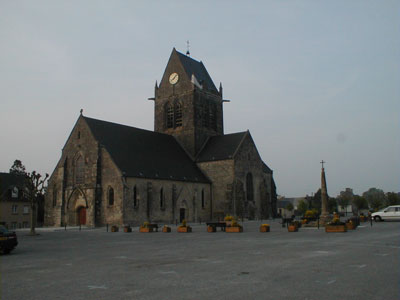 |
This is the St. Mere Eglise where an American paratrooper of the 82nd Airborne was stranded for a few hours during the early stage of the invasion. His parachute caught the steeple and he hung there while his fellow soldiers landed and attempted to take the town. In memory of the events of these days, the town keeps a mannequin attached to a parachute that is draped over the steeple.
|
 |
Another view of the church and a memorial to the Americans who liberated the town. There were a number of informational signs in the nearby area explaining what happened in the town (like a when a German caught an American paratrooper as his prisoner, but when he heard more Dakotas flying overhead, filled with paratroopers, he turned around and surrendered to the American) and photographs of the fighting in the town. It was interesting to compare the town in the photographs to the town today - not much has changed.
|
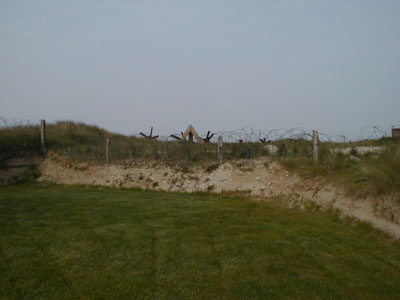 |
We also visited Utah Beach and walked along it, as it was low-tide and there was a lot of beach. Here you can see a collection of devices used to protect the beach from Allied attack - barbed wire and metal and concrete barriers. The beach today is free from any of this debris.
|
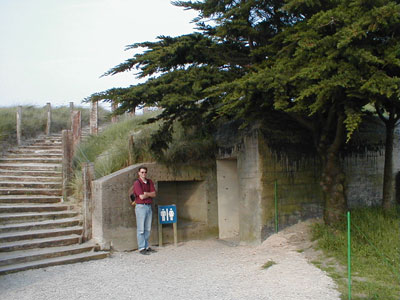 |
This is a German bunker on Utah beach that has been turned into a bathroom.
|
 |
A view from the water toward Utah beach. The memorial museum is on the left. Unfortunately we came too late to tour the Utah Beach Memorial Museum. Maybe next time.
|
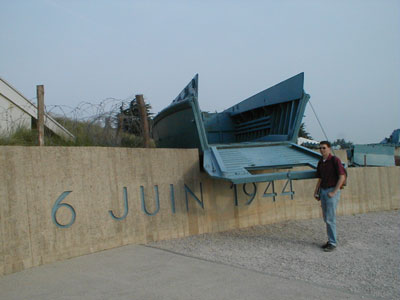 |
One of the landing craft that was used on this beach.
|
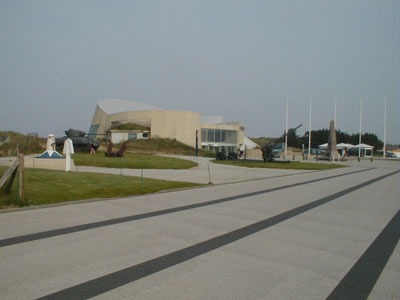 |
The Utah beach museum and memorial. There is a small collection of landing craft and tanks in this area.
|
 |
Me standing by the tank on the memorial site.
|
|







